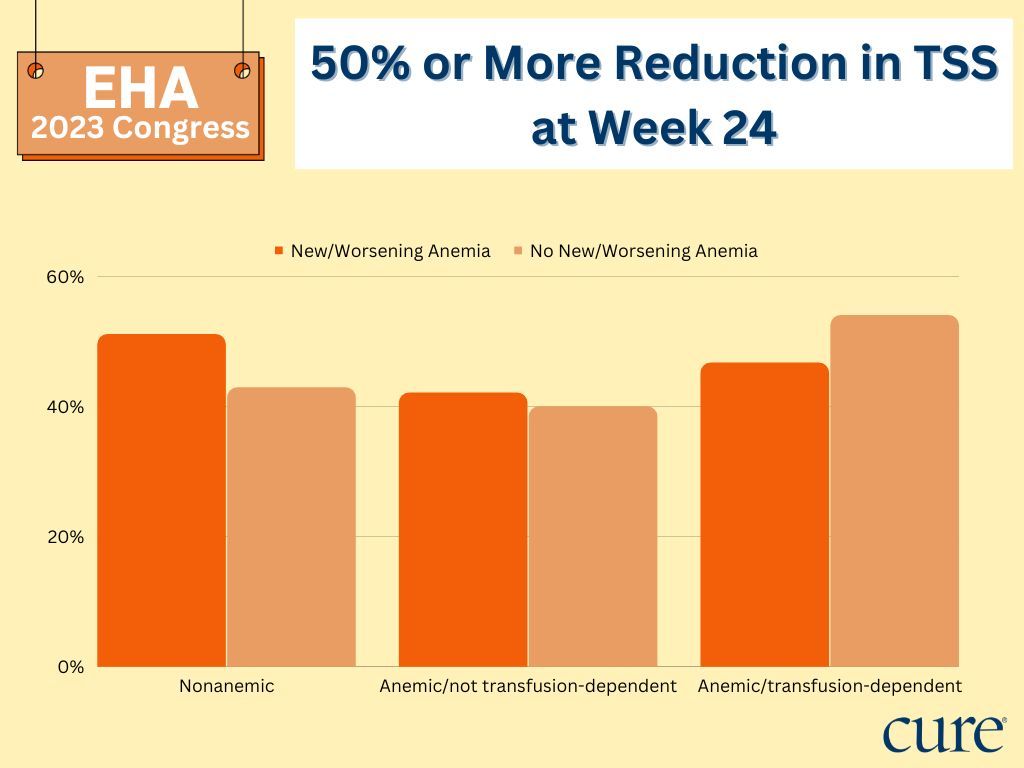Article
Jakafi Improves Symptoms, Spleen Volume in Myelofibrosis
Author(s):
Jakafi led to improved symptom score and spleen volume reductions in patients with myelofibrosis, regardless of anemia or transfusion status, recent research showed.
Patients with myelofibrosis who took Jakafi (ruxolitinib) tended to see an improvement in their spleen volume and overall tumor symptom score (TSS), regardless of their anemia or transfusion status, according to analyses of the phase 3 COMFORT-I and COMFORT-II trials presented at the 2023 European Hematology Association Congress.
A common and potentially dangerous effect of myelofibrosis is spleen enlargement, which Jakafi can address. Study results showed that the reduction in spleen volume of 35% or greater from baseline rates at week 24 in patients with new or worsening anemia up to week 12 were 48.8%, 33.3% and 41.4%, respectively, for those who were nonanemic, anemic/nontransfusion dependent, and anemic/transfusion dependent at baseline. These rates were 43.2%, 23.1% and 28.2%, respectively, in patients who did not have new or worsening anemia at week 24.
A 35% or more splenic reduction at week 48 was achieved in 42.1%, 44.1%, and 34.6% of patients who had new or worsening anemia and were nonanemic, anemic/nontransfusion dependent, and anemic/transfusion dependent at baseline compared with 42.4%, 22.2%, and 27.3% in those who did not have new or worsening anemia.
Jakafi led to a reduction in tumor symptom score in patients with myelofibrosis, regardless of their transfusion or anemia status, research showed.

A 50% or greater reduction in TSS — which looks at factors such as fatigue, night sweats, itching, discomfort, weight loss, fever and others — at week 24 was achieved by 51.1%, 42.1% and 46.7% of those with new or worsening anemia up to week 12 and who were nonanemic, anemic/nontransfusion dependent, or anemic/transfusion dependent at baseline. In patients who did not have new or worsening anemia up to week 12, these rates were 42.9%, 40.0% and 54.2%, respectively.
Jakafi, a JAK1/2 inhibitor, is indicated for patients with intermediate- or high-risk myelofibrosis. The FDA approval for Jakafi in this setting was based off findings from the COMFORT-I and COMFORT-II trials. Findings showed that Jakafi demonstrated a reduction in spleen volume, improved myelofibrosis-related symptoms, and prolonged overall survival, which is defined as the time from treatment until death of any cause. This was in comparison with placebo in COMFORT-I and with best available therapy (BAT) in COMFORT-II.
Transient dose-dependent anemia is a treatment-related side effect that has been observed with Jakafi. In COMFORT-I, grade 3/4 anemia occurred in 45.2% of patients on Jakafi compared with 19.2% with placebo. In COMFORT-II, the most frequently reported serious adverse effect in both arms was anemia (5% with Jakafi vs 4% with BAT).
Therefore, in the post-hoc analysis presented during the congress, investigators sought to determine how new or worsening anemia from Jakafi treatment impacts spleen volume response and TSS in this patient population.
Patients were treated with Jakafi twice daily with an initial dose based on platelet count. For those with a platelet count of 100 to 200 x 109/L, the dose was 15 mg vs 20 mg for those whose platelet count was above 200 x 109/L. Stratification factors included anemia status at baseline (yes vs no) and transfusion status at baseline (transfusion dependent vs nontransfusion dependent).
Anemia was defined as hemoglobin less than 100 g/L and patients were considered transfusion dependent if they received two or more units of red blood cells over eight to 12 weeks before their first dose of Jakafi. Investigators stratified outcomes via presence or absence of new or worsening anemia postbaseline, which was defined as a decrease in hemoglobin of at least 15 g/L or new transfusion requirement at weeks four, eight or 12.
Specifically, investigators assessed patients with a reduction in spleen volume of at least 35% from baseline from the pooled COMFORT-I/-II data at weeks 24 and 48, and with at least a 50% reduction in modified Myelofibrosis Symptom Assessment Form TSS at week 24, from the COMFORT-I data.
A total of 277 patients were included in the analysis. Regarding baseline characteristics, the median age ranged from 65.0 to 71.0 years, and between 47% and 56% were male. More than half of patients were baseline nonanemic (154 patients; 55.6%) 19.9% (55 patients) were anemic/nontransfusion dependent, and 24.5% (68 patients) were anemia/transfusion dependent.
For more news on cancer updates, research and education, don’t forget to subscribe to CURE®’s newsletters here.





